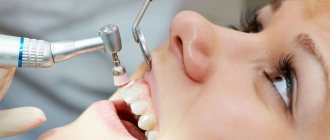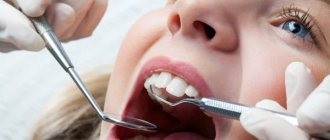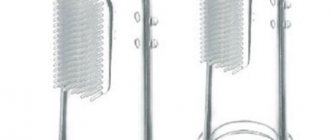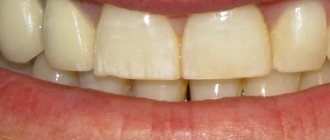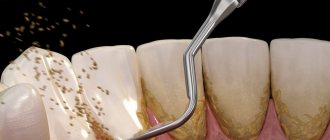Healthy teeth and a beautiful smile are not a gift from nature, they are daily care and proper protection. Daily brushing of your teeth using professional products, mouth rinses, and dental floss will help you protect your teeth from caries and other oral diseases. But, unfortunately, it is not always possible to completely clean your teeth even in the most secluded corners - this is how plaque appears on the teeth, and later tartar , which cannot be removed with a paste and brush. This will require professional teeth cleaning at the dentist's office.
To maintain the effect of the procedure and protect your teeth from various damage and diseases, you must follow a number of doctor’s recommendations, because teeth require special care after brushing. Family Dentistry Medical Center offers you a list of the most important tips:
Preventive measures
To avoid inflammatory processes in the oral cavity and relieve mild pain in the teeth, which sometimes occurs after removing tartar, you can rinse your mouth with medicinal decoctions, for example, St. John's wort, sage or even chamomile tea, which can be purchased at any pharmacy. If your teeth or gums continue to bother and hurt for a long time after hygienic cleaning, you should consult your doctor to make sure everything is okay.
Professional teeth cleaning, as well as home care, is an important and necessary procedure. By following all the doctor’s recommendations, not forgetting about the rules of hygiene, as well as regular preventive visits to the dentist and timely treatment, this is the only way you can protect your teeth from various diseases and defects. The health and beauty of your teeth depends on you, so take care of them from an early age!
Treatment and prevention measures
To reduce the risk of developing hyperesthesia, fluoridation is carried out after professional hygiene with the removal of tartar. Procedure:
- saturates the enamel with useful substances that help strengthen it and restore its structure,
- reduces the likelihood of developing caries.
To avoid enamel hypersensitivity after removing tartar, you must follow the following rules:
- do not eat or drink for two hours after the procedure,
- give up solid and rough foods for a day,
- use a toothbrush with soft bristles,
- Use mouth rinses regularly.
To maintain healthy teeth and gums, professional hygiene with the removal of soft bacterial plaque and tartar should be carried out twice a year.
How is tartar formed?
Stone formation begins when plaque remains on the teeth after eating. At first soft and friable, in the absence of proper oral hygiene, it gradually reacts with the components of saliva, oxidizes and hardens. Over time, layers of plaque mineralize and tartar forms.
Plaque, which eventually turns into tartar, comes in two types:
- Subgingival
Plaque that can form on any tooth, regardless of its location. You won’t be able to detect it yourself; this can only be done by a doctor using a probe or gum recession.
- Supragingival
This plaque usually forms on the teeth closest to the salivary glands and has a yellowish or gray-brown tint. You can detect it in the oral cavity yourself, but it can only be removed with the help of a dentist.
Do your teeth hurt after brushing? Let's figure it out!
A snow-white smile and beautiful, straight teeth these days have become not just very popular, but also an extremely necessary feature of appearance, on which the quality of a person’s social communication, his professional career, and success in his personal life depend. Nowadays, many people use the services of specialists working in the field of aesthetic dentistry and regularly undergo professional dental cleaning. But not everyone is aware of the intricacies and features of such a procedure, so they wonder why their teeth hurt after brushing , for example, with the advertised safe ultrasound?
Learn more about the benefits of teeth whitening and teeth cleaning
Mechanical stone removal
Mechanical method
Initially, tartar was removed only mechanically - using a special metal hook, which was used to separate the stone from the tooth. The procedure was quite painful and traumatic, so in recent years this method has not been popular; it has been replaced by more effective and much less traumatic ones.
Causes of the inflammatory process
Inflammation of the gums after cleaning tartar most often occurs in people with sensitive enamel. The inflammatory process can be triggered by:
- existing diseases of the oral cavity - caries, pulpitis, periodontitis,
- microcracks in tooth enamel,
- toothpastes with abrasive components,
- traumatization of soft tissues and mucous membranes with a toothbrush with hard bristles.
When several factors are combined, the likelihood of developing an inflammatory process increases.
Problems of dental hypersensitivity during professional oral hygiene
- The use of personal hygiene products for teeth with increased sensitivity.
Unfortunately, modern personal hygiene products for the care of teeth with increased sensitivity provide a short-term effect. And some time after treatment, the patient again shows signs of hyperesthesia. Filling is carried out only if there is a defect in hard tissues. Tooth depulpation is resorted to when all of the above methods of eliminating hypersensitivity are ineffective.
Therefore, professional products such as fluoride-containing gels and varnishes have become widespread for the prevention and treatment of dental hypersensitivity. Gels typically contain low concentrations of fluoride and are recommended for weekly home use for persons over 18 years of age [3].
Unlike gels, fluoride-containing varnishes can remain on the tooth surface for a long time, thus promoting the accumulation of more fluoride in the enamel [2]. This is especially important at a time when demineralization processes predominate. However, when applying conventional fluoride varnishes, calcium fluoride crystals are freely located on the surface and are quickly removed by mechanical abrasion, making the effect short-lived. Therefore, preference should be given to drugs with a longer effect [7].
In our practice, for many years, we have successfully used fluoride-containing products such as VOCO Profluoride Varnish and Bifluoride 12 (VOCO, Germany). Prevention and treatment of hyperesthesia with the help of these drugs are based on closing the mouths of the dentinal tubules with calcium fluoride plugs, which, in turn, block the movement of fluid through them. This leads to a reduction and, ultimately, elimination of the occurrence of unpleasant sensations when exposed to thermal, chemical or tactile stimuli on the teeth.
"VOCO Profluoride Varnish»
is a fluorine-containing varnish based on a special resin (colophonium) containing 5% sodium fluoride. Fluoride ions, together with calcium ions present in the tubules, promote the precipitation of calcium fluoride, which leads to reliable sealing of the dentinal tubules. Along with this, VOCO Profluoride Varnish forms a depot of calcium fluoride on the tooth surface, which protects the tooth from acid attacks, promotes remineralization and the formation of fluorapatite. In addition, xylitol, which has a caryostatic effect, is added to the varnish. Colonium resin provides good adhesion, also on wet surfaces. Therefore, unlike other fluoride-containing preparations, VOCO Profluoride Varnish can be used successfully when it is impossible to dry the surface of the teeth well.
“Bifluoride 12” is a unique transparent fluoride varnish, which is a colorless suspension based on natural tree resin with a pleasant fruity smell and taste. I would like to note that all fluoride varnishes present on the dental market have an active ingredient of sodium fluoride, which has a short-term effect - 2-3 days. The main active components of Bifluoride 12, in contrast, are 6% sodium fluoride and 6% calcium fluoride. It is the presence of calcium fluoride that contributes to better penetrating ability of the drug and provides a long-term therapeutic effect - the release of fluoride occurs over several months.
It is obvious that conventional fluoride varnishes, which are natural resins, do not form a very strong film on the surface of hard tooth tissues, and calcium fluoride crystals are freely located on the surface and are quickly removed by mechanical abrasion, making the effect short-lived [6].
The composition of “Bifluoride 12” includes bioinert Teflon particles, which give it strength properties, and the submicroscopic CaF2 crystals formed during its application are not located on the surface, but directly in the pores of the loosened zone of enamel, dentinal tubules and in the cement of the tooth root. Bifluoride 12 dries quickly, so to obtain long-term adhesion to the enamel it should be applied in a thin layer. To maintain the anti-caries effect, re-coating must be carried out after 3-6 months. Single-layer application of varnish saves the doctor’s time and reduces consumption to a minimum, on average 66% more economical than analogues.
It is important that the problem of dentin sensitivity has led to the creation of a new class of complex drugs aimed at eliminating it: these are dental desensitizers, for example, Admira Protect (VOCO, Germany).
Desensitizers reduce hypersensitivity by sealing the dentinal tubules, that is, they have a “plug-forming” effect [1, 4].
Admira Protect includes several components balanced to achieve maximum desensitizing effect: HEMA (hydroxymethyl methacrylate) and aminofluoride. HEMA acts as a wetting agent, creating the necessary moisture in dentin and preventing the collapse of collagen fibers. This allows the surface layers to be easily impregnated with the main component, developed using a special organic matrix filling technology to thoroughly seal the dentin. Active fluorides help strengthen the structure of hard dental tissues, as they are able to penetrate them and obstruct dentinal tubules, reducing the sensitivity of dentin [2].
Since Admira Protect is a synthetic varnish, it forms a more durable film on the tooth surface compared to preparations based on natural and natural-synthetic resins. It is enough to apply the drug once every 6 months.
Here is a clinical example.
- Patient A., 62 years old, came to the therapeutic dentistry clinic for the purpose of sanitation of the oral cavity. Before the start of sanitation, the patient was recommended to carry out professional hygiene (Fig. 1, 2). Removal of dental plaque was carried out using an ultrasonic device of the piezoelectric type “P Max”, Satelec (Fig. 3); polishing the tooth surface - using an air-abrasive tip “Air-Flow Handy 2”, EMS (Fig. 4). To prevent the occurrence of hypersensitivity in the patient, taking into account slight bleeding of the gums after professional cleaning, Bifluoride 12 applications were used (Fig. 5). After 1 application, her symptoms of dental hypersensitivity disappeared.
rice. 1 Initial clinical situation. rice. 2. View from the lingual surface. rice. 3. Polishing with an air abrasive device. rice. 4. Application “Bifluoride 12”. rice. 5. View after application.
- Patient M., 46 years old, came to the clinic for a preventive examination. It was recommended to carry out professional oral hygiene, to which the patient agreed. After removing dental plaque and polishing the surfaces of the teeth, it was decided to apply the drug “Admira Protect” (Fig. 6-9).
rice. 6. Application from the vestibular surface of the Admira Protect desentitizer, fig. 7. Drying with a jet of air. rice. 8. Photopolymerization of the drug. rice. 9. Final look.
Thus, the use of professional products that reduce tooth sensitivity and seal dentinal tubules is one of the most effective, reliable and fastest ways to eliminate dentin hypersensitivity, both when used independently and in complex treatment of this pathology.


